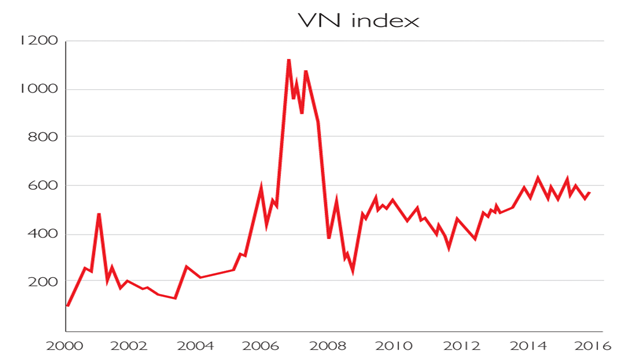
Vietnam is one of the most promising economies in southeast Asia, with a young, relatively well-educated population that gives it the potential for decades of strong growth. Progress has been uneven, in part due to legacies of the country’s communist era, such as bloated, inefficient state-owned conglomerates, but the economy broadly seems to be moving in the right direction.
GDP has grown by around 6.5% per year over the past decade, with the export sector playing a key role: trade has grown by around 20% per year over the same period.
Lower wages compared to China mean that Vietnam is an increasingly competitive location for manufacturing and regional free-trade agreements, such as the Trans-Pacific Partnership, should help export growth continue. Rising foreign direct investment in industries such as electronics – Korea’s Samsung is the country’s largest foreign investor – will enable the manufacturing sector to accelerate the shift from goods such as textiles and furniture to more sophisticated, higher-value industries.
Recovering from the crash
This promising story hasn’t always resulted in strong returns for investors: Vietnam saw a spectacular stockmarket bubble and bust in the mid-2000s and shares largely trod water for many years afterwards, as the chart above shows. Returns for foreign investors were even worse, since the Vietnamese dong has dropped by almost 30% against the dollar (and more than 10% against sterling) over the past decade. The aftermath of crashes like this often takes some time to work through, but for the last three or four years the market has been showing tentative signs of recovery and the outlook is encouraging.
Most importantly, the market is fairly cheap. The VN index trades on a price/earnings ratio of around 12 and a dividend yield of 4%. That makes it one of the cheaper markets globally, especially given its growth potential. In addition, the Vietnamese government recently removed some limits on foreign ownership of listed firms, which had previously been capped at 49% – although this doesn’t apply to state-owned companies and sectors considered “strategically important”, such as banking and defence.
This may help to increase foreign investment, especially if it gives Vietnam a better chance of being upgraded from “frontier” to “emerging-market” status by index compiler MSCI and hence allows it to be included in the MSCI Emerging Markets index, the key benchmark for emerging-market investors.
A long-term holding
However, there’s no guarantee of economic progress – the government may backtrack on crucial reforms, for example. Still, in our view Vietnam is an attractive bet for long-term investors who are willing to ride out the inevitable ups and downs of an emerging economy.
One way to invest is via the VinaCapital Vietnam Opportunity Fund (LSE: VOF), a closed-end fund that invests in Vietnam-listed stocks, unlisted companies and real estate. The fund has just moved from Aim, where it has been listed since 2003, to the main market. This should improve its liquidity, allow it to reach a broader investor base and lead to its inclusion in the FTSE All-Share index, says Andy Ho, VinaCapital’s chief investment officer. VOF currently trades at a discount to net asset value of 26%, but this may narrow over time if interest in the fund increases.
Alternatively, larger investors could consider the PXP Vietnam Emerging Equity Fund, an open-end fund that invests almost exclusively in listed firms. The minimum investment is $100,000. For subscription details see PXPam.com.